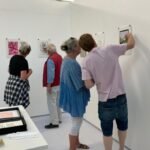
Most artists, when they’re in need of supplies, go to the craft store to pick up paints, brushes and the like. For Matthew Monahan, stocking up on art supplies could mean grabbing a fishing pole and heading out to a body of water, having someone ship him a frozen fish or stopping by the grocery store to see what the local fishmonger has in stock or is able to procure.
Monahan is a printmaking artist. Specifically, he practices the art of gyotaku. This Japanese technique started out as a means of record-keeping, Monahan says. Before the advent of photography, gyotaku provided a way for Japanese fishermen to catalog their catches, and eventually, function evolved into form — with gyotaku becoming an art.
When Monahan goes to make a print, the fish is his canvas (it’s sterile, so it doesn’t smell). He applies his inks to the fish’s body, uses tweezers and forceps to adjust fins and teeth, and then when the fish is ready, it’s time to bring out the paper. Monahan has drawers full of various types. Deciding which kind of paper to use is informed by years of experimentation, he says. Some make better prints, while others look nicer.
To make a print, Monahan mists water to wet his paper, which makes it easier to apply to the contours of the fish’s body and facilitates a better transfer of ink to paper. Making the first print is like making the first pancake, Monahan says. It’s not as nice; it can be splotchy; but it’s a warmup for the next one.
“Printmaking, some people say, is problem solving, and there’s a lot of truth to that,” Monahan says as he demonstrates his process with a speckled sea trout from the Gulf of Mexico.
There’s more to the process than just the initial print, and Monahan works in phases over time to create a finished piece. As a full-time teacher, robotics coach and father of five, Monahan says it can be hard to find time to make as much art as he would like to. But when the time comes to make a print, he has a freezer filled to the brim with potential subjects.
Trout, bass, bluegills, octopuses and more have all featured in Monahan’s works. When it’s all said and done, the final product is “something of a resurrection, an immortalization of the fish,” he says.
There’s an element of faith that informs Monahan’s art, and the printmaker refers to God as “the ultimate transcendent artist.” For many people, nature is invisible, leading to “a tremendous lack of care for the world,” Monahan says. Practicing his art, capturing the allure of nature, gives Monahan the feeling that he is like an image-bearer of God, making “beautiful things just as He has made beautiful things all through history.”
And yet, Monahan also says it is impossible to capture the full depth and complexity of each specimen.
“Every one of these prints — no matter how hard I try — it all falls short of the beauty of the actual creature, but trying to do it is an incredible challenge,” he says. “And the results are still rewarding, even though the print of the fish is nowhere near the beauty of the fish itself.”
Recounting how he got started with gyotaku, Monahan says he’d take a school group fishing each winter, and they would eat what they caught. An art teacher with printmaking experience suggested printing the fish, and so it became a tradition for the group to catch, print and fillet their bounty. At a showcase for the students’ work, there would also be a fish fry — a mix of high-brow and low-brow, Monahan says. They said that it was probably the only time in life when you could eat a fish while looking at its portrait.
Even today, Monahan says he often cooks and eats the fish he uses to make his art, once they’ve been memorialized on paper.
So the next time you’re in the seafood section of the supermarket, ask yourself, “What would that fish look like on my wall?”
Find Monahan’s work at themightybluegill.com.











